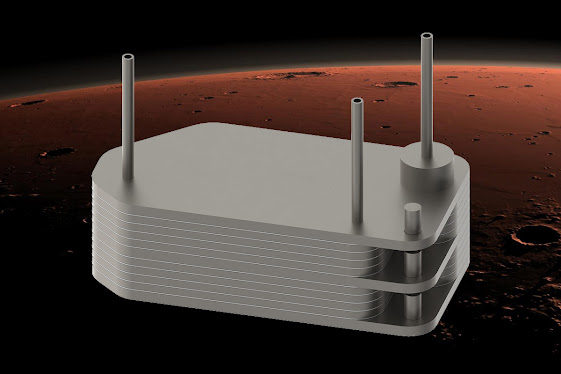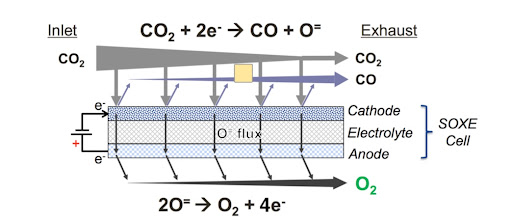A key lever to our Mars colonial success, as NASA puts it, is putting oxygen generation technology feasibility on the agenda. I think it's great that NASA phrases MOXIE as a tool that leads to human footprints on Mars. This helps us focus on the calmer, long term vision behind the pivotal moment when the equipment and crews launch from Earth and deploy on Mars.
Image of MOXIE unit in preparation ahead of launch back in Aug 2020. Credit NASA/ JPL
The technology behind this unit is very similar to that of a hydrogen fuel cell. By allowing gas in one end, an electrical current and heat are applied to an internal sandwich of the solid electrolyte. However, this is different to the
It is instructive to look at the internal schematic of the MOXIE unit. Seeing below, there are many of the components that would be required in a scaled-up version of the unit, as would be used by a human crew. Already, we can see a processing unit, the Electrochemical cell, the sensor bank, electronic control box and compressor.
MOXIE unit exploded internals view - Credit Eric Hinterman, MIT
Above we can see a more detailed view of the content of the MOXIE unit. Here we can see the key elements which would be required of any 'commercialised' unit which could support Martian human missions. This includes:
Electronic control equipment - power management, on/ off for cycling of the equipment
Sensor Panel - From my experience working in Upstream Oil and Gas - A key part of utility system design (be it fuel gas conditioning for Power Generation, nitrogen, or oxygen process gas preparation, or even simply utility water for general and process use), is sensing the quality of the output of the production system.
Sensor Suite - This sensor suite will relay back to the human crew about quality, while also feeding back to the electronic control box to allow rejection or recycling of the O2 to enable reprocessing to meet set point on quality - whether on contaminants - for MOXIE - it is the excess Carbon Monoxide in the oxygen stream left over from processing. But primarily, it is whether the concentration of oxygen in the product stream is high enough. The target in this paper by Eric Hinterman suggests that 99% concentration of oxygen is appropriate for use by the crew. This can be for experiments, research. This could also be for welding and cutting tools.
However, given the inert atmosphere already on Mars, this could help even further on higher quality welds.
Buffer Tanks - Any pre-preparation ahead of crews arriving would likely be focussed with supplying an oxygen output to a tank. A pressurised tank would store the gas until human crews arrived and used it.
Compressor - the compressor on this equipment is the more efficient scroll compressor. These compressors are already in use in the newer models of HVAC and refrigeration equipment (specifically in the external condenser unit). They offer higher efficiency as for their mode of operation, progressively compressing the gas to a higher pressure. When coupled with a variable speed drive, which they often are, they also offer the chance to ramp up and ramp down their throughput (because it is a compressor - is measured in mass flow rate). This is in contrast to other types of pumps which typically turn on and off, causing hammer in the lines and stress on the equipment.
Starship rendered unto Mars - Credit: ErcXspace
The author of this paper, Eric Hinterman, calculated that the MOXIE unit aboard Perseverance would provide approximately 0.5% of the capacity required to support a 4-person martian mission.
As mentioned in previous posts, redundancy and back-ups of back-ups would be the mode of operation of SpaceX and NASA (the most likely candidates to collaborate on a human-crewed mission.
A key element of the MOXIE system is the SOXE stack - the Solid OXide Electrolyte stack. This is a technical nomenclature which describes a porous catalyst, substrate sandwich. The raw reactant gas - Carbon Dioxide, enters in one end, a current and heat is applied by the equipment - using a 300W load from the Perseverance power supply - radio-powered Thermo-electric generator (fun fact- such technology can also be used to 'turbocharge' the cooling in your home computer.).
Out the exhaust comes the waste products from the reaction - Carbon Monoxide and excess Carbon Dioxide. Out of the product stream comes the pure Oxygen (touted to be approximately 99% Oxygen by mass).
Bear in mind that oxygen at high concentrations, significantly above our normal 21% volume in air are hazardous to humans in a variety of ways. The chief and most immediately dangerous of these is the fact that as oxidisers go - high concentration oxygen is excellent. This means that having high concentrations in a small space, and a spark would instantly cause an explosion and catastrophic decompression of the module affected.
Not only is oxygen at high concentrations an explosive agent, it also can, understandably, give human health problems. As we know. Humans are evolved to operate in an atmosphere roughly 21% oxygen by volume, with the rest being inert gas. When we step outside of this limited set point, we encounter problems. At low concentrations - we see hypoxia - initial light-headedness gives way to choking, suffocation and rapid brain death.
At a higher-than-required concentration, it can be a stimulating agent similar to a drug - users report euphoria. However, chronic high concentration exposure can lead to lung damage, eyesight problems. At even longer term exposures, like our crew - trapped in a confined space for long periods - this could lead to cells not reproducing - such an outcome would lead to death quite soon - given that blood cells are replicating from our bone marrow all the time - and themselves have a fairly short life-span (typically 120 days).
Rather instead: high concentration, high quality oxygen would typically be stored at pressure, near the human habitat, and diluted down with nitrogen and other components for consumption by the crew.
MOXIE's SOXE stack - the heart of the technology to generate O2 on Mars, in this experimental unit. Credit : OxEon Energy
What good looks like.
What Perseverence and its MOXIE are trying to prove is not whether the reaction works - the chemistry has already been defined well on Earth. Rather, this extended experiment - set to run in cycles, cycling the equipment for MOXIE on and off, to determine effectiveness over time on Mars.
Remember - the MOXIE unit will take in CO2 from the atmosphere, but also very fine martian dust. As we know from High school chemistry, any fouling of a catalyst can cause it to stop working rather quickly.
This is a key criteria for success for this part of Perseverance's mission.
Another aspect is longevity - how well with the equipment itself cope mechanically, physically with the demanding hot and cold cycles of mars (albeit the hot comes only when the equipment operates at target temperature of 300 degC. The cold, when it is not operating, and the Martian temperatures cause the unit to plummet to - 74 degC - in Summer.
Bear in mind too - We cannot simply benchmark the performance of MOXIE to an oxygen generation package available on Earth. If we did, we could compare normal parameters when considering machinery: comparing the size, power requirements, efficiency, longevity - as these equipment are deep-duty, and long life for the Martian context. There is no spare parts van around the corner.
This is because oxygen generation packages, also called pressure swing adsorption plants - such as the Atlas Copco brand machine pictured below - operate by compressing the air around us, then using a swing in pressure to selectively desorb gases from the substrate. By doing this - oxygen is retained longer - because of higher affinity for the substrate, and is then sent forward as an output.
This option to simply scrub oxygen from Martian atmosphere does not presently exist - the atmosphere on Mars being 99% CO2 as discussed earlier. It is more to the pity - because these machines can create output gases with high quality - up to 99.99% pure Oxygen or Nitrogen, depending on what you want.
Remember MOXIE aboard Perseverance is only a prototype to prove the technology in the Martian context. It is there to help us figure out the way forward, and how to troubleshoot and anticipate as many problems as we can before humans make footprints on Mars.
You can reach me on Twitter: @Ronnie_Writes






Comments
Post a Comment